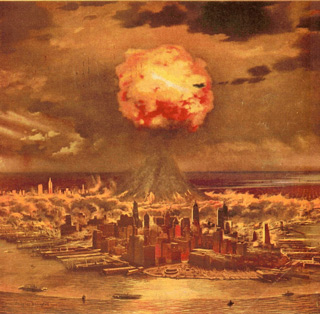|
Aerial bombing brought destruction to European and East Asian cities just before and during the Second World War. Beginning with Guernica in April 1937, and continuing through London, Coventry, Dresden and Tokyo, before ending with Hiroshima and Nagasaki in August 1945, the war demonstrated the vulnerability of cities to aerial attack. During the war air armadas comprised of as many as a thousand aircraft carrying high explosives and incendiaries attacked many cities, while two were struck by lone bombers armed with an atomic weapon.

Americans watched these developments from afar, awed by the destruction, but comforted by the sense that their cities lay beyond enemy reach. As the Cold War with the Soviet Union unfolded in the late 1940s, however, and that nation developed atomic capabilities and long-range heavy bombers, this feeling of security disappeared.
By the early 1950s many Americans believed their cities faced real and imminent threats from Soviet air attack. In response, the Army began deploying Nike Ajax missiles around major U.S. cities and military-industrial centers.
Nike Ajax was the world’s first operational guided surface-to-air antiaircraft missile system. It was developed by the Army in conjunction with several defense contractors between 1945 and 1954. The Army eventually built more than 300 Nike missile batteries to protect some 40 priority targets.
As deployed in the United States, Nike missile batteries encircled potential targets in a ring 20 to 30 miles beyond the target’s center. These batteries comprised a final, inner “ring of steel” that might protect a city or other target if more distant defenses, such as flights of fighter-interceptors, failed.
In 1955 Fort Slocum became host to a Nike Ajax missile battery, one of 19 built in the suburbs around New York City.
|




 Air Defense
Air Defense